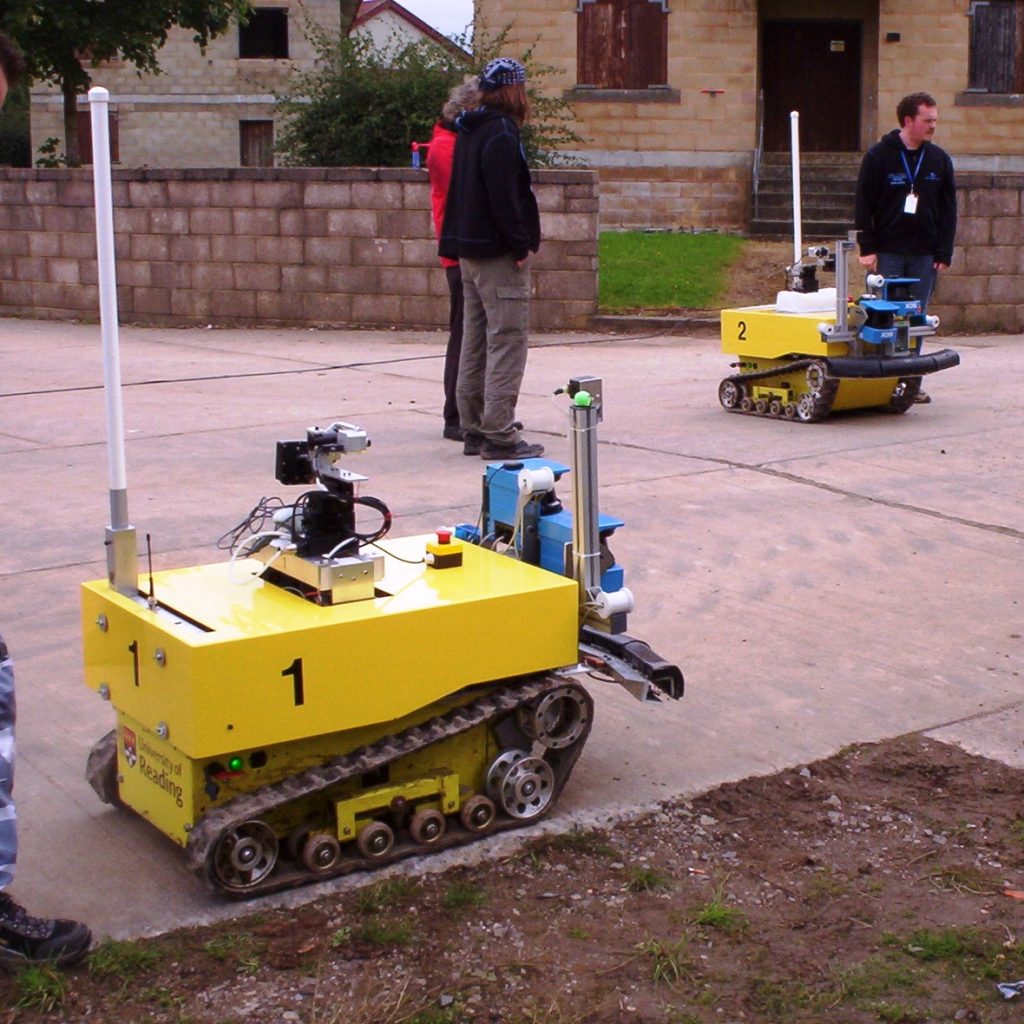Securotrack Robot Platform
Are you looking a robotic platform that is more robust than the usual four wheels on a box?
The Securotrack, originally developed for the Thales Team in the MOD Grand Challenge in 2008, makes and excellent choice, particularly for harsher or outdoor environments.
We are now seeking collaboration partners to build a Securotrack-based Covid-19 Disinfection robot
The Securotrack™ is an electrically powered high-speed propulsion unit intended mainly for remotely controlled vehicles and robots. It is designed to be easy to integrate with autonomous robotic software.
Features
Its motor controllers are capable of accepting quadrature and similar displacement-commanding pulses. This means the platform can behave as if it is being driven by a pair of stepper motors. Alternatively, it can accept velocity signals that offer full forward and reverse proportional speed control.
It can driven up to a surprisingly high maximum speed of 10Kph (6Mph) and its ramped front enabling easy stair climbing and descent. It can be supplied with high capacity batteries to give it a continuous run time exceeding two hours, potentially far longer. The run time is enhanced by integral regenerative braking.
The Securotrack™ features a fixed radius configuration. This ensures the tracks cannot come off nor can the drive lugs jump whatever the operating conditions. In addition, the contact section of the tracks feature intermediate rollers pivoted in pairs. This spreads the load and and optimises the Turnability Index on all surfaces.
Its width of 685mm makes it narrow enough to fit through doorways and its length of 990mm allows it to carry out a zero-turning circle U-Turn in passageways of 1219mm (~4’) width or greater.
We can build the Securotrack with a variety of body/chassis materials, including T6 Aluminium, if weight is and issue, Steel if strength and fire resistance are priorities, or Fibreglass with steel frame.
We have designed the Securotrack’s hull as a sealed unit, to allow it to run through shallow water. If we fit a sealed top, it could have a design IP rating of 66. This would allow it to be hosed down with a pressure washer if used on a ship’s deck without the electrical system suffering from water damage.
Suggested Applications
The Securotrack™ can be used as a platform for:
- Autonomous Disinfection Platform
- Security Robotics
- Remote Firefighting (see Firemote)
- Telepresence Applications
- EOD (Bomb Disposal) – The Securotrack™ can move slowly and accurately
- CBRN (Chemical Biological Radiological and Nuclear) monitoring, wash-down, etc.
- Defence – perimeter patrol
- Tracked Wheelchair – For adventure wheelchairing
- Inhospitable location remote vehicle usage – Antarctic, Arctic, Desert,
- Danger area usage – mines, demolition sites, disaster areas, poisonous gas leakage areas, active volcanic areas
- Film Industry – Remote camera mount or prop moving
- Factory Workpiece movement
- Emergency Service Support
- Agricultural

ORIGINAL APPLICATION
We supplied two Securotrack™’s to Thales for use in the MOD Grand Challenge (see right). Thales and Reading University built and mounted a semi-autonomous system that used a combination of instructions via a wireless network, GPS and LIDAR guidance to enable the vehicles to navigate Copehill Down Training Village looking for threats using thermal imaging cameras. Overhead surveillance was done with remotely operated helicopters that also provided the relay for the wireless links. The Thales team won the Best Use of Talent Award.
COVID-19 DISINFECTION ROBOT
APPLICATION SUGGESION
This would make the ideal platform for an outdoor autonomous robot for overnight disinfection of public spaces to help combat Covid-19 and other infectious diseases.
How it would work
An onboard tank, pump and sprayer on a multi-axis arm would provide the chemical disinfection for outdoors (park benches, etc)
UVC Lamps would provide the close-range and indoor disinfection
A combined GPS LIDAR and IP sensors via an autonomous system would control the machine.
